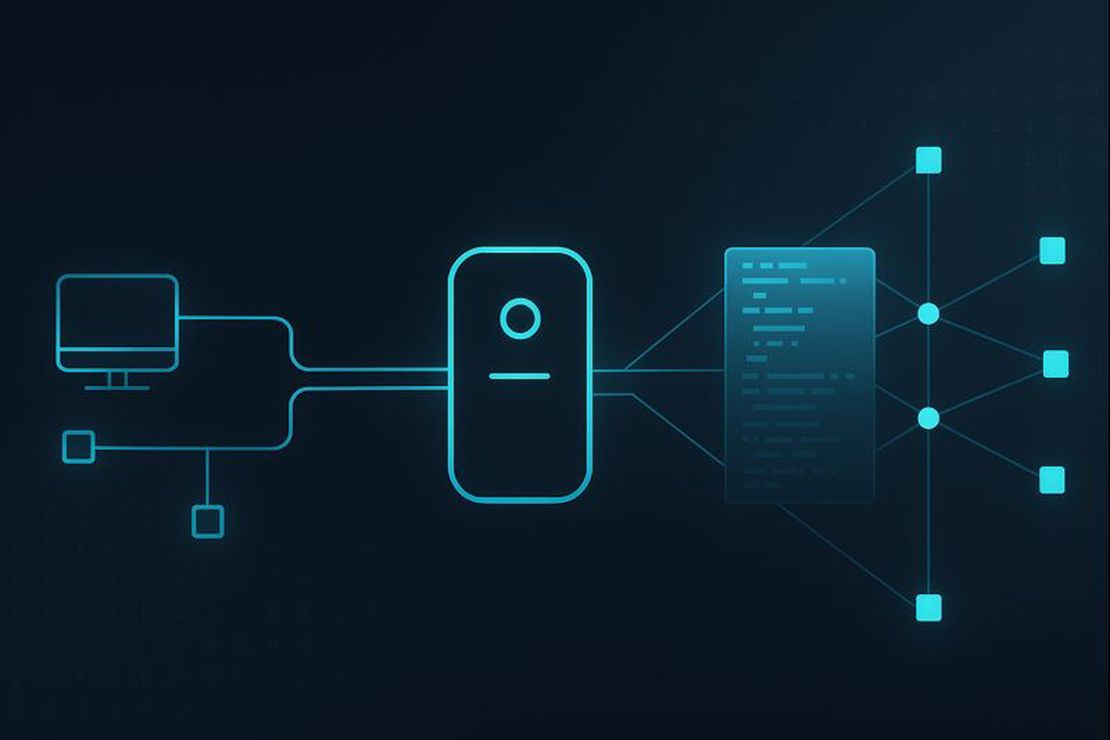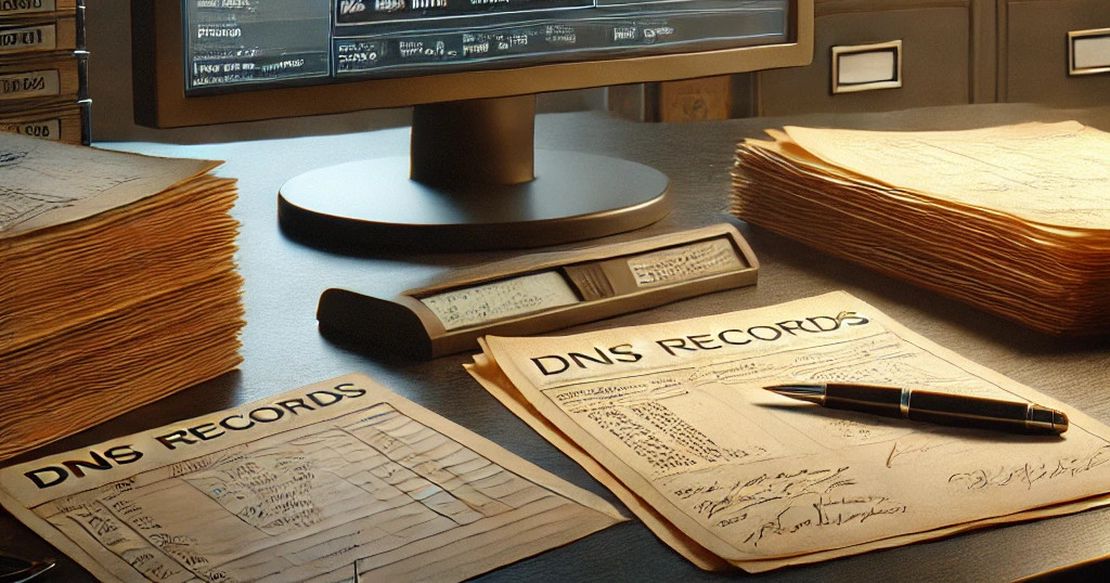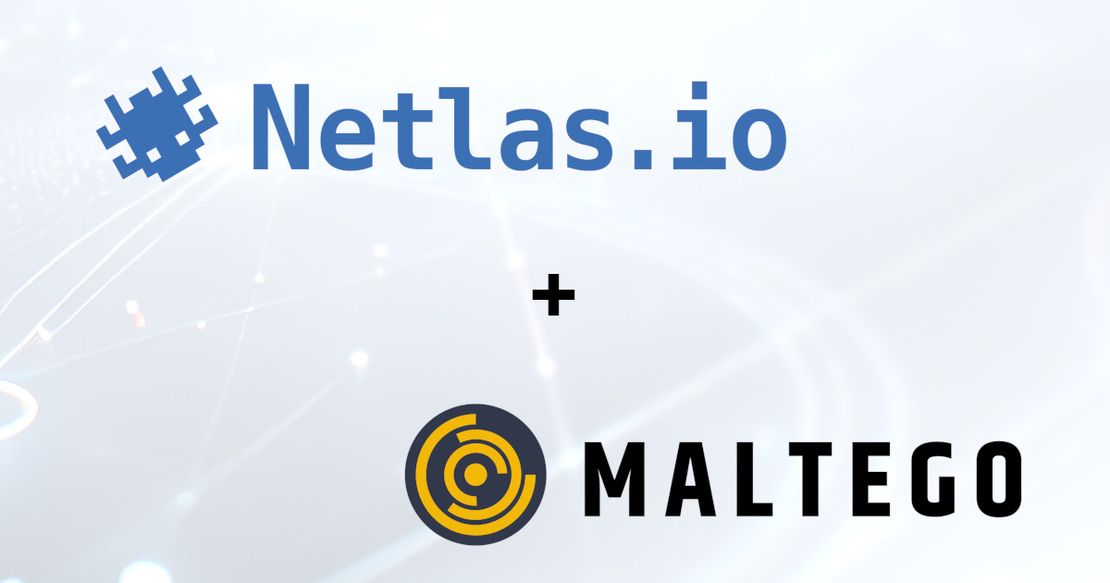DNS History: Exploring Domains Past by Inspecting DNS Trails
June 11, 2025
11 min read
What can you learn from examining the history of DNS records associated with a domain? As the name implies, DNS history logs every change made to a domain’s DNS configurations over time, offering key insights into domain management, security trends, and even potential vulnerabilities. This data is crucial for both protecting your online presence and shaping long-term strategy.
In this article, we will dive deep into the concept of DNS history, detailing the types of DNS records that reflect changes and providing you with an overview of the tools available for retrieving these valuable insights. Focusing on real-world applications, this guide will demonstrate how to utilize historical DNS data not only to strengthen your domain’s security but also to gain an edge over competitors and optimize your digital presence. By understanding DNS history, you can improve your domain’s resilience and make informed decisions about its future.
Key Insights on DNS History and Domain Data
Reviewing DNS history reveals important details about the progression of a domain, its traffic patterns, potential vulnerabilities, and can be instrumental in diagnosing connectivity issues or service interruptions.
Several free and paid tools, including SecurityTrails, DNS Spy, and other specialized services, provide in-depth DNS record history and offer robust analytics, making them essential resources for domain administrators, cybersecurity professionals, and network engineers.
Request Your Free 14-Day Trial
Submit a request to try Netlas free for 14 days with full access to all features.
Understanding DNS History and Its Role in Security
DNS History tracks the progression of domain names over time, recording changes in IP addresses, settings, and configurations. This historical data plays a critical role in cybersecurity, allowing professionals to monitor domain activity, detect potential threats, and understand how changes could impact security posture. Reviewing the history of DNS records helps in recognizing trends, detecting weaknesses, and confirming that domain settings follow optimal security protocols.
Advantages of Analyzing Historical DNS Records
Examining the progression of DNS records provides a detailed look at the changes applied to a domain’s configurations throughout its history. This extensive archival information can empower domain managers and website proprietors in numerous ways, including:
- Verifying traffic routing following significant changes like moving to a new hosting provider.
- Identifying trends that may reveal security vulnerabilities or unauthorized modifications in domain registration.
- Linking past DNS configurations to malicious behavior or cyberattacks.
The DNS history serves as a detailed timeline, offering deep insights into the life of a domain, and plays a key role in both site management and security efforts.
Various platforms have meticulously cataloged DNS changes, with some holding records dating back to 2002. Long-standing solutions like SecurityTrails and Complete DNS — active since the early 2000s — remain in high demand. Additionally, many practitioners lean on search platforms such as Netlas, Shodan or Fofa for their broader data coverage. Below, we’ll review a variety of tools designed for digging into DNS history.
Why DNS Records Are Vital for Domain Protection
DNS records are foundational elements that quietly ensure the smooth operation of the internet. They act as essential links between domain names and IP addresses, facilitating the resolution process across various internet services. For example, A records link hostnames to IPv4 addresses, serving as one of the most widely used types of DNS records. Similarly, AAAA records fulfill a parallel role for the newer IPv6 addresses, supporting the growing number of devices connected to the internet.
In addition to these, other key records contribute significantly to domain functionality and security:
- MX records define mail servers, playing a critical role in managing and directing email traffic.
- NS records delegate authority, specifying which name servers handle the domain’s resolution process.
- CNAME records allow one domain to point to another, facilitating easier domain management and redirection.
- PTR records are responsible for associating IP addresses with domain names, useful for reverse lookups and troubleshooting.
By analyzing historical DNS records, domain administrators gain crucial insights that aid in DNS forensics, particularly when identifying suspicious activity. This historical data is instrumental in tracking cybercriminal movements and reinforcing domain security, allowing for prompt actions to safeguard online assets.
Best Free Tools for Performing DNS History Lookup
Now that we’ve established the importance of DNS history, the next step is figuring out how to access it. Fortunately, several free tools are available that help with discovering domain details, identifying potential threats, and reviewing your domain’s past DNS activity. Some of these popular tools include:
- SecurityTrails (formerly DNS Trails): Offers comprehensive DNS history analysis, providing detailed information on past and current domain configurations.
- DNS Spy: A real-time DNS monitoring tool that tracks changes and alerts users about any suspicious DNS alterations.
- Complete DNS: A tool that provides access to DNS History and reverse NS record searches. It is distinguished by its very large amount of data.
- Netlas: Internet-connected devices search engine, which provides users with DNS records data, among other things. A fairly young tool, which compensates for the lack of age of the data with its diversity.
These tools are instrumental in retrieving historical DNS data and can assist domain administrators in conducting thorough investigations, improving domain security, and enhancing overall management strategies.
Exploring DNS Trails: How to See DNS Changes Over Time
SecurityTrails is a tool for investigating DNS history and offers a wide range of features to help users track DNS changes:
- Extensive DNS record database providing access to historical domain data.
- Free access to 50 API queries, allowing users to automate the retrieval of DNS information.
- Daily updates on DNS changes, keeping you informed with the most current domain records and configurations.
- Customizable data feeds, enabling users to download both real-time and historical data for in-depth analysis.
This tool is particularly valuable for those who need to monitor changes over time, including updates to TXT records or other DNS configurations. It is a good resource for tracking modifications and ensuring accurate domain management, security, and compliance.
The picture below shows an example of a report obtained from SecurityTrails.

By clicking on the “Historical data” button, you’ll be able to view the historical records for the selected domain. Let’s take a closer look at the A records as an example.
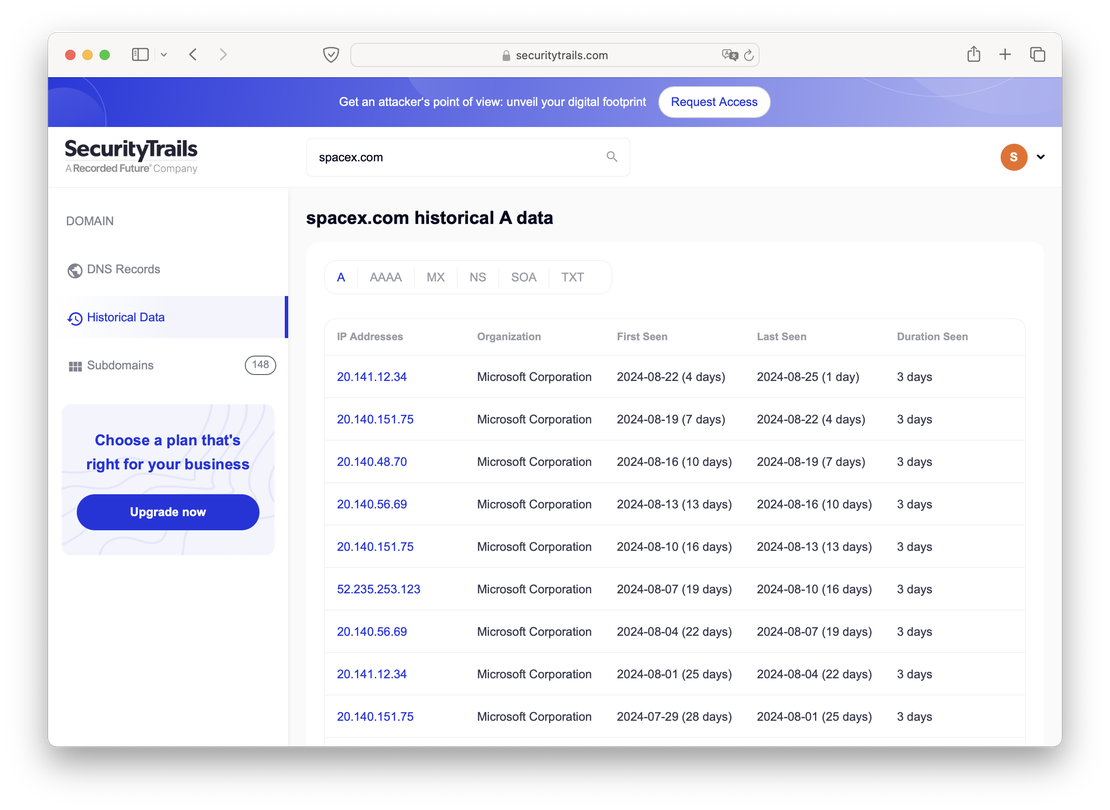

In-Depth DNS Analysis: A Complete DNS History Guide
Complete DNS is another resource for understanding domain history and tracking changes as they occur. One of its key strengths is the ability to present a timeline of domain modifications, making it invaluable for thorough historical analysis. Users can access 100 free queries each month through the free tier, enabling them to check domain history without incurring any costs.
For those requiring more advanced capabilities, Complete DNS offers a subscription plan that unlocks extra features, such as:
- Increased query limits, allowing for more extensive research into domain activity.
- Advanced filters to focus on specific types of DNS records.
- Detailed reporting tools for better analysis and insights into domain performance and changes.
This tool is perfect for both basic checks and comprehensive DNS history investigations, offering flexibility based on user needs.
The following image shows an example of using Complete DNS.
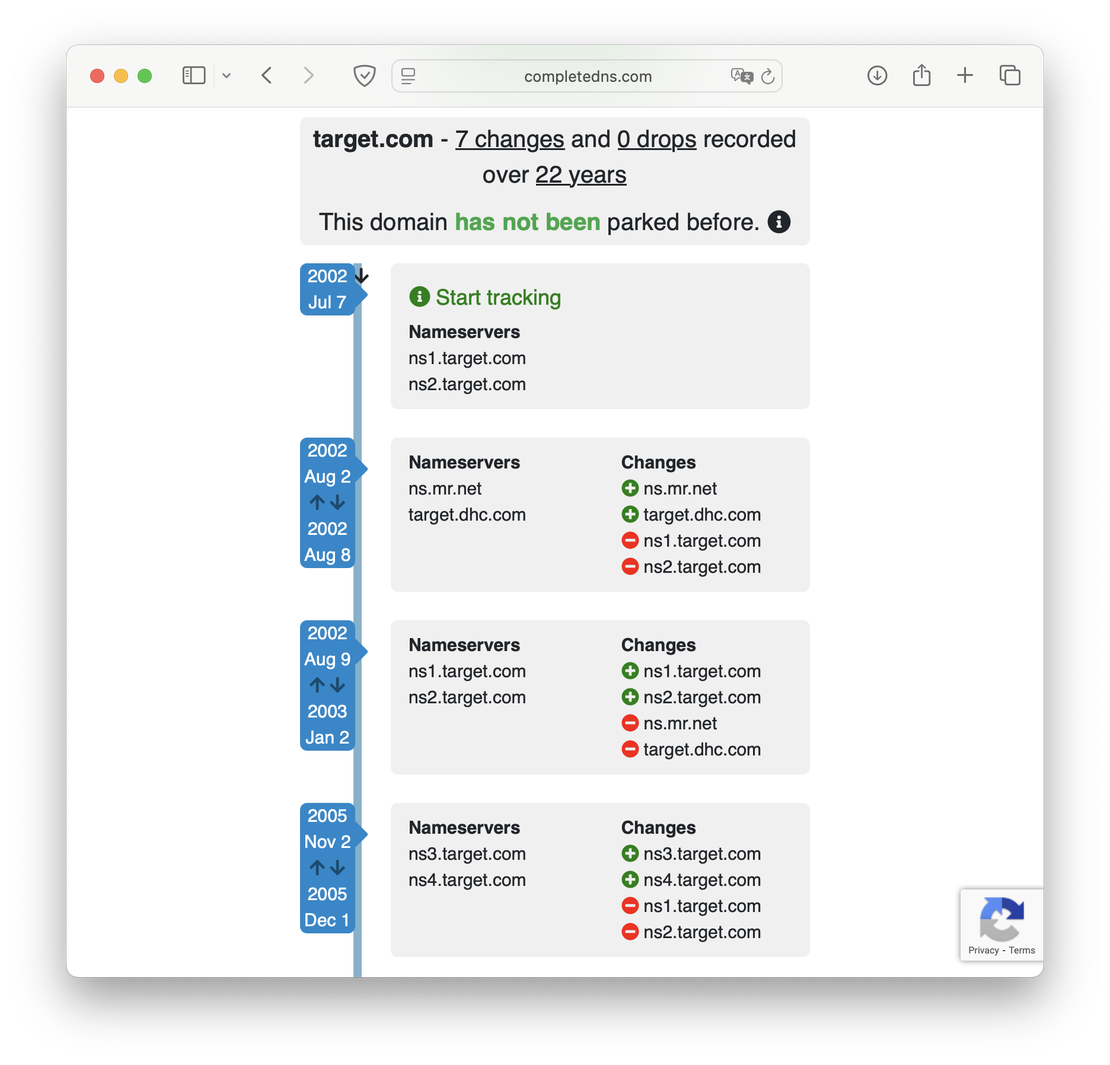
IoT Search Engines: Netlas
As already mentioned, one of the ways to obtain historical DNS records is through internet-connected devices search engines. You can read more about some of them in the related articles: Shodan, Fofa, Censys. In this one, we will briefly mention the functionality of Netlas in the context of DNS History research.
The necessary functionality in Netlas is contained in the DNS Search tool. It provides the following features:
- Search by all main types of DNS records, including reverse.
- Use of wildcard characters, for example, in domain names.
- Free access to old scans for DNS History research.
The picture below shows an example of using Netlas to view DNS records.
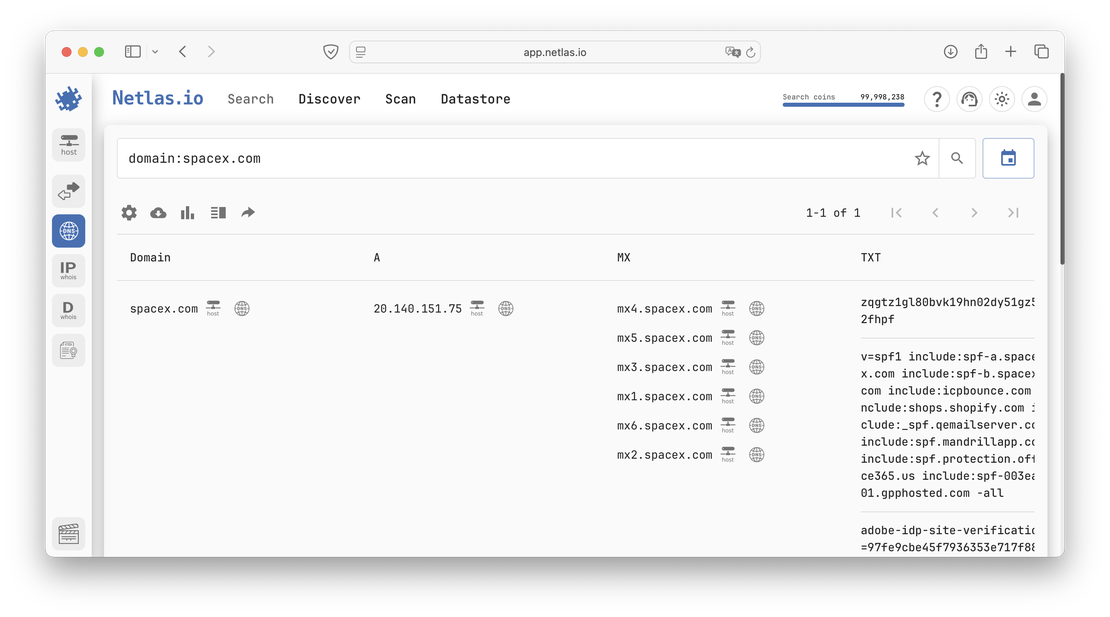

Next, using old indexes, you will be able to access historical data.
Premium Services for Accessing DNS History and DNS TXT Record History
Leveraging the SecurityTrails DNS History API for Deep Insights
The SecurityTrails DNS History API is an integral feature of the SecurityTrails API, providing users with access to historical data about DNS records tied to specific hostnames. This tool allows for the retrieval of past DNS information across different record types, as well as providing insightful statistics comparing historical and current data.
The SecurityTrails API offers several important features:
- Extensive Historical Data: Gain detailed insights into past DNS records for any given hostname, including various record types and statistical data.
- Data Enrichment: Enhance your applications with additional information such as IP details, DNS configurations, WHOIS data, and company information—ideal for SIEM systems and security platforms.
- RESTful Access: Utilizes a REST API for straightforward integration with systems via HTTP methods like GET and POST, making it easy to retrieve data programmatically.
- Read-Only API: This API allows for retrieving data without altering or storing information, helping maintain integrity and security of the data.
- JSON Data Format: All data is transmitted in JSON format, ensuring simple parsing and seamless integration with different systems.
One of the major advantages of using the SecurityTrails API is its ease of access from virtually any environment. A simple curl request can retrieve the desired DNS history data:
curl --request GET \
--url https://api.securitytrails.com/v1/history/oracle.com/dns/a \
--header 'accept: application/json'This simplicity allows users to effortlessly integrate SecurityTrails DNS History into their workflows for in-depth domain research and security analysis.
Tracking DNS Changes with DNS Spy: A Real-Time Monitoring Tool
DNS Spy is a DNS monitoring solution that offers users powerful tools for tracking and managing DNS changes in real time. The platform comes equipped with several useful features, such as:
- Automated Detection of DNS Changes: Seamlessly detects and tracks changes in DNS entries, ensuring that all modifications are promptly observed.
- AXFR Zone Transfers: Enables comprehensive DNS record coverage by supporting AXFR zone transfers for better visibility into your DNS infrastructure.
- Minimizing DNS Downtime: Focuses on reducing the impact of DNS outages by alerting users to potential disruptions before they affect service.
- Backup and Restoration: Protects domain integrity with backup functionalities, allowing users to restore DNS configurations from various formats.
Additional functionalities of DNS Spy include:
- Alerts for DNS Misconfigurations: Sends notifications when DNS settings are invalid or non-compliant, helping avoid errors and security issues.
- Custom Notification Options: Provides users with customizable alerts, which can be sent via email or Slack, tailored to specific DNS record changes.
- Support for DNS Migrations: Assists with DNS migrations, ensuring smooth transitions between DNS providers or setups without any disruptions.
- DNS Health Dashboard: Offers a central dashboard to give a quick overview of all monitored domains and their DNS health status, helping administrators stay on top of their DNS infrastructure.
With these comprehensive features, DNS Spy makes tracking DNS changes effortless, providing real-time insights and enhancing the reliability and security of domain management.
IoT Search Engines Paid Functions
As noted above, we touched on search engines for internet-connected devices. Each of these platforms offers paid plans to extend their capabilities, yet they seldom introduce wholly new features—mostly they build upon existing ones. Consequently, for Netlas, Shodan, and Fofa, the premium tiers typically include:
- Upgrading to a paid Netlas plan boosts user’s monthly query allowance and result limits.
- On Shodan, DNS lookups and access to historical records are gated behind the Membership-level subscription.
- Fofa’s premium tiers follow a model similar to Netlas, expanding query volume and data access.
When it comes to DNS History alone, stepping up to a premium plan on these search platforms offers little extra value. That said, it’s worth keeping in mind that each of these tools is a versatile powerhouse with applications far beyond just DNS analysis.
Tips for Effective Historical DNS Data Analysis
Performing consistent reviews of your DNS setups is crucial for ensuring their accuracy and relevance, ultimately preventing performance bottlenecks and security vulnerabilities. This practice not only helps in maintaining up-to-date configurations but also ensures that any inconsistencies or issues are identified and addressed before they impact your domain.
To enhance your DNS analysis process, consider the following strategies:
- Set up automated audits: Use software solutions to organize periodic DNS evaluations, ensuring that every entry is accurately set up and remains current.
- Monitor for discrepancies: Compare past and present DNS data to spot any unusual changes or inconsistencies that could signal problems.
- Track DNS performance: Use historical DNS data to assess response times and identify any slowdowns or performance issues.
- Integrate security checks: Make security a priority by analyzing DNS data for any potential vulnerabilities or unauthorized changes that could expose your network.
- Regularly review backup records: Ensure that historical backup records are accessible and functional, which helps in restoring configurations quickly if needed.
By incorporating these techniques into your workflow, you can effectively manage and analyze DNS data, ensuring the continued security and performance of your domain infrastructure.
Restoring Lost DNS Records with Historical DNS Services
In a modern DevOps workflow, you often juggle application development alongside managing DNS zones and records. When a record is updated and fully propagated, the previous values disappear from public view—pinging the domain always returns the new IP, making rollback difficult.
Fictional scenario: A site administrator accidentally overwrote a critical A-record while performing routine maintenance. Hours later, every resolver worldwide reflected the new IP, and there was no internal backup of the old setting.
Generic recovery approach:
- Choose a historical DNS service. Select any from the previously listed tools (e.g., SecurityTrails, Complete DNS, Netlas).
- Query historical records. Use the service’s web UI or API to request past values for the record type and domain in question.
- Locate the timestamped entry. Identify the exact date and value you need.
- Restore in your DNS console. Copy the retrieved old record into your DNS provider’s interface or IaC configuration and publish the change.
How to Perform a Comprehensive DNS History Lookup
Whether you need to investigate a questionable domain or recover previous records, you can follow this generic workflow with any DNS history provider:
- Access the service portal. Open your preferred DNS history tool’s website.
- Enter the target domain. In the search field, type the domain you want to examine.
- Authenticate (if required). Log in with your credentials or sign up for a free account.
- Locate the historical data section. Look for a tab or menu labeled “History,” “DNS Timeline,” or similar.
- Choose the record type. Select the specific DNS record (A, AAAA, MX, CNAME, TXT, etc.) you wish to review.
- Review and export. Examine the list of past entries—each will include a timestamp and the record value. Export or copy the relevant data for your recovery or analysis.
Identifying Security Risks: How to Check DNS History for Threats
Accessing historical DNS data is an invaluable tool for detecting security vulnerabilities not only within DNS records but also across your entire network, applications, and services. It provides insights that can help in various critical areas, including:
- Assessing potential cybersecurity risks
- Resolving legal matters related to domain ownership and history
- Preventing interruptions to online services and applications
- Performing thorough investigations during corporate acquisitions or mergers
- Analyzing and visualizing your domain’s previous attack surface
Furthermore, leveraging DNS intelligence is crucial when monitoring new assets on your cloud infrastructure, helping businesses navigate the challenges of tracking and securing these assets.
Investigating Cybercrime Through Domain Name History Lookup DNS
Investigating cybercrimes often involves examining historical DNS records to trace the movement of domain names across various hosting services and servers. This method is instrumental in identifying malicious actors and their digital footprints. A prime example of the effectiveness of this approach can be seen in high-profile investigations led by both private and public organizations.
For instance, in 2019, KrebsOnSecurity uncovered a series of large-scale DNS hijacking attacks, leveraging historical DNS data to track and identify the sources behind these widespread breaches. This investigation demonstrated the crucial role that DNS history plays in exposing cybercriminal activity and securing online environments.
Recommended Reading
Using DNS History in Cybersecurity
Tracking Competitors by Analyzing DNS Record History and Changes
Monitoring competitors’ DNS modifications can provide valuable insights into their business strategies, including:
- The launch of new ventures or projects
- Potential upgrades to their technology or network infrastructure
- Shifts in their subdomain layout, signaling growth or the introduction of fresh offerings
- A closer look at the IP addresses linked to their domain, which could reveal details about their hosting strategies and affiliations with other companies
Delving into historical DNS records can expose a competitor’s past decisions on hosting, domain acquisitions, and SEO strategies, all of which contribute to their current position in the market. By evaluating these historical insights, businesses can adjust and fine-tune their own strategies for greater success.
The Importance of DNS History and TXT Record History for Secure Domains
This article has delved into the significance of DNS history, exploring its advantages and key applications, including both free and premium tools available for analysis. By recognizing the value of frequent DNS audits and how they can reveal security vulnerabilities and competitive tactics, we’ve highlighted the critical role that DNS history plays. Understanding TXT record history, in particular, enhances your ability to secure domains and track changes over time, ensuring that you stay ahead in terms of both security and strategy.

Book Your Netlas Demo
Chat with our team to explore how the Netlas platform can support your security research and threat analysis.
Related Posts

August 30, 2024
Using DNS History in Cybersecurity

June 25, 2025
theHarvester: a Classic Open Source Intelligence Tool

January 20, 2025
Using Maltego with Netlas Module

July 13, 2024
Best Attack Surface Visualization Tools

February 7, 2025
Using Subfinder with Netlas Module

December 27, 2024
Using theHarvester with Netlas








